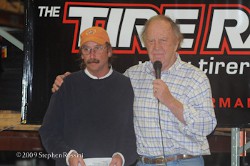
If you are a NASCAR fan, the term “start and park” is something you have probably heard a time or two. It has become a point of contention between many fans, teams, and NASCAR itself, but I am not here to judge. I am here to point out the challenges of marketing a NASCAR team, and particularly one that is frequently criticized for this practice.
I had a dinner meeting with the owner of a NASCAR race team last night. He is in the hunt for sponsorships, so it was right up my alley. I was very excited about the meeting, because beyond being a lifetime gearhead, I am also a highly trained driver, I have owned a race team, and I have sponsored multiple race teams. I could help him to get those sponsorships, and this is the kind of work I would take on for free. Well, except that I still have a family of five to support, and that it is hard to work for free when others wave their money in my face.
The meeting reminded me, once again, how very misinformed a lot of people are about marketing, social media, SEO, public relations, reputation management, and other online communications. You know, the kinds of communication that remove roadblocks and make something popular. It also reminded me why I once wrote an article titled “When I Go to Hell, They Will Have Me Selling SEO“. It really made it clear to me that, although I rank number one in search engines for “sell seo”, being good at online marketing and having the patience to explain it to people are two entirely different skill sets.
I have basically come to the conclusion that people will either “get it”, or they won’t. They either see the value in building a brand and giving people reasons to love their brand, or they don’t. They may even say that they want to understand this whole Internet thing beyond Twitter being for telling people what you had for lunch and Facebook being a place to swap stories with high school friends. The reality is that beyond all the education I try to give them, what they really need is confidence in their own business. So, let’s look at this NASCAR dilemma for a moment.
What makes NASCAR racing possible? I mean, in a single word, what is the thing that makes it happen? Is it the gasoline, the cars, the drivers, the adrenaline, the passion for the sport of auto racing? Sure, NASCAR needs those things, but what ultimately gets those cars around the race tracks?
A lot of people would say that it comes down to the money, and that is true, but that is still not the word I’m looking for. Sponsorship money is important. Without a sponsor to pay hundreds of thousands of dollars per race, per car, many teams change careers to become professional parking teams instead of racing teams.
How Big is NASCAR Big?
To understand the importance of marketing in NASCAR, I think you have to look at how much money is involved. If you want to be competitive in NASCAR Sprint Cup Series, don’t plan on starting a team unless you’ve got twenty million to invest (yes, $20,000,000). The car may just be a measly hundred thousand, but if you want it to go fast, you can expect to spend three to four million per season for your engine lease program. You will need about fifteen sets of four tires per week, and of course, some skilled people to put those tires on a car. You will need to guarantee your driver at least a few hundred thousand (actually a million and up is more like it) plus 30 percent of your take. You will need your driver and crew to have NASCAR licenses, so you will drop anywhere from fifty thousand to a quarter million, depending on how big your staff is. Each of those crew will probably need to eat, so you will need to pay them. If you want good ones, you will need to pay them very well, so plan on about $5,000,000 in personnel cost. You will need to buy a lot of race fuel, a garage, some trucks, and be ready to pay $100,000 fine from NASCAR and have your car taken away if your fender is one sixteenth of an inch too high. You get the idea, right? It is expensive.
That sponsorship money is big … really big! Teams are paid anywhere from a hundred thousand dollars, on up to $850,000 for a single race. So, what are those sponsors getting out of the deal? That is the big multi-million dollar question. Just consider how silly it sounds to drop a half million dollars for a few stickers on a car. Well, that actually would be really silly, but it is not just about those stickers. It takes a whole lot more than that if it is to make good business sense for the sponsors. After all, just imagine how many targeted ad impressions a half million dollars will buy using Google or Facebook ads, or hiring a guy like me to handle their online marketing.
Most business people who can afford a seven to eight digit multi-race contract can also do the math and realize that their brand will not get their money’s worth from those people watching from the stands. They will not get their money’s worth if they end up on television for a few laps. They get their money’s worth when the team takes on the responsibility of marketing that brand far beyond the race track. That means it is the sponsored team’s job to do what it takes to improve the sponsor’s return on investment in every possible way.
Teams that do a good job for their sponsors will go to great lengths to put the sponsors’ names in front of the public. Many teams will spend easily over $175,000 per year to tour the USA with a show car. You’ve seen them at car dealerships, grocery stores, state fairs, and other events. It costs a lot of money to haul those cars around and pay a staff to shake hands and answer questions. They will also do more than just keep their fingers crossed and rub a lamp while hoping to be interviewed by the media. They make it happen!
The amazing thing I found is that very few of them take the Internet seriously, or they are otherwise doing a poor job of it. They don’t realize the powerful connections available for media exposure, or the ways the Internet works into, or even supersedes the value of a flash-in-the-pan moment on television. At least that is the way it appears to me, and I’ve done a little checking on this.
The Tone of NASCAR on the Internet
You can find an amazing amount of chatter on the Internet about NASCAR, if you’re looking. It should not be surprising that a lot of it is centered around arguments. Arguments about NASCAR rule changes, who did what, who is the best driver, who caused that big crash, and other rather heated discussions.
You will generally find a lot fewer stories of the good things teams are doing. Bad news travels faster than good news. Without a fair dose of good news, it is really easy for a team to either disappear, or become disliked.
One of the things many NASCAR fans really dislike are the “start and park” race teams. What is a “start and park” team, you may ask? Those are the teams that go out to the race track each week for qualifying, but once they qualify to be in the big race, they run a minimal number of laps and then make an excuse to drop out of the race early.
Why would they do that “start and park” thing? It is really easy … they get paid for it … a lot! If the car qualifies for enough races, runs the minimal laps, and finishes the season with enough points to be in last place, they still get millions of dollars in purse money. The problem is that a whole lot of people hate this kind of “racing”, because there is very little competition in it. It is for the money, and not for the sport.
The driver will radio in to the crew chief to say the car is not working right. They may say it has a strange engine noise, or a vibration. Although the drivers usually want to strangle somebody for this, they will need a good excuse. Although the NASCAR organization tries to sweep this start and park phenomenon under the rug, they don’t like it. They say it is not a problem within their organization, but they also seem far more likely to discover reasons to fine teams like this an extra $25,000 from the crew chief and $25,000 from the owner for something silly like “unapproved door braces” (true story).
When a NASCAR Sprint Cup Series team gets tagged as a “start and park” team, it is really hard to change the fans perception of them. That makes it ever harder to receive a decent sponsor. After all, who wants to put their company name and a bunch of dollars on a non-racing team that fans disrespect? Although a lot of teams would never admit that this is a cause to reorganize their company and actually change their team name, it definitely happens.
This brings me back to that word I was looking for earlier, about what makes NASCAR all possible. That word is “fans”! Without fans, it is a whole lot harder to get sponsors, and harder to compete in full races. A problem that I found is that some people will get this backward and think they will get more fans after they find a good sponsor and have a chance to be competitive. The problem becomes a discussion of what came first, the chicken or the egg.
There is a really huge difference in the profit margins of teams that compete, and teams that park after twenty laps. In between the profitable comfort zone of parking the car early to avoid wear and tear, crashes, tires, fuel, and etcetera, and actually becoming a competitive race team, there is a big gap. The gap has risks involved. You can lose a whole lot of profit by staying in the race until the checkered flag is waved. If you make it across that gap, there are many, many, many millions of dollars up for grabs.
How Would You Seek a NASCAR Sponsorship?
If a team really wanted my corporate sponsorship, they will already be doing the things that build a fan base. Even if they don’t have the highest number of fans just yet, they had better show me that they are worthy and capable of building a loyal fan base. Don’t tell me that the team will be popular after I sponsor them … they need to be popular and do popular things to give me a reason. After all, it is their job to bring fans to my company, and not my company’s job to bring them fans.
If a team holds a lot of promise of building brand recognition for my corporate sponsorship dollars, we will work in synergy. That means we will both build their fan base by working together with a common strategy. If they are just trying to sell me on how good they could be, while their reputation is being castrated online, I am out the door!
Not so unlike becoming a rock and roll music legend, it would be ridiculous to ask for a recording contract based on musical talent alone. If you want the contract, you had better have some marketing talent and a fan base. Otherwise, it brings up the vitally important question: “If you are so talented, why don’t you have fans waiting in line to buy your music?”
NASCAR Thinking Summarized
Something struck me as both silly and sad when I parted ways with that NASCAR team owner last night. He said, “Well, Mark, you think about all of this and let me know how you can help us.”
Building and implementing a strategy to entice millions of dollars from sponsors is not a one-race fix, and it won’t come easy. I don’t need to think about it … I already wanted to help him. I suppose he wanted more specifics, but all I can offer for free is a taste. The strategy buffet requires an investment.
What I perhaps didn’t quite make clear enough is that “thinking about how I can help them” is approximately 80 percent of what I am paid to do. My job is not to lift heavy objects, or even to type on this keyboard. My job is to think about how I will help them, and make it happen. My job is to do the research, model the audience, define a creative strategy, and then see that plan through to perfection.
I could think about it a whole lot for free, but until he has enough faith in that race team to engage my services and put my thinking to good use, I am unable to help. I think the better parting question would be “How can I stop wasting the racing season and start getting sponsorships.”
If you are one of those race team owners or management wondering “How can I attract more sponsors for my NASCAR team?” I’ll give you a really simple tip. Pick up the phone and call me at *REDACTED DUE TO AGING WEBSITE*.
Podcast: Play in new window | Download






